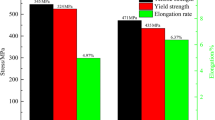Abstract
The effect of different shot-peening treatments on the cyclic fluctuating bending fatigue behavior of a new aluminum-lithium alloy (the 2091) has been investigated. The residual-stresses in-depth profiles have been defined just after the shot peening using mainly the X-ray diffraction method. To reach a given depth inside the material, the surface layer was removed by electro-polishing. The acquired data had to be then corrected in order to account for the redistribution of the stresses during the polishing. Furthermore, this alloy contains up to 15-percent intermetallic precipitates. Moreover, the X-rays penetrate deeply inside the material (23 μm). For these reasons, a special procedure, based on a self-consistent micromechanical scheme, has been developed to correct the acquired data. The stress profiles obtained by this procedure are compared to those obtained by other mechanical experimental methods and those calculated by a theoretical shot-peening method. Shot peening improves the life of the material but the surface residual stresses are partially released during the first cycles of fatigue and are then quickly stabilized.
Similar content being viewed by others
References
Harding, J., “Effect of Temperature and Strain Rate on Strengths and Ductility of Four Alloy Steels,” Met. Tech.,4, (6), (1977).
Harding, J., “The Temperature and Strain Rate Sensitivity of α-Titanium”Arch. of Mech. 27,715 (1975).
Hoge, K.G., andMukherjee, A.K., “The Temperature and Strain Rate Dependence of the Flow Stress of Tantalum,”J. Mat. Sci. 12 1666 (1977).
Sizek, H.W. andGray, G.T. III, “Deformation of Polycrystalline Ni 3 Al at High Strain Rates and Elevated Temperatures”,Acta Met. Mat.,41, (6),1855–1860 (1993).
Gray, G.T. III, and Rollett, A.D., “The High-Strain-Rate and Spallation Response”, High Strain Rate Behavior of Refractory Metals and Alloys, ed. R. Asfahani et al., The Minerals, Met. and Mat. Soc. (1992).
Rosenberg, Z., Dawicke, D., Strader, E., andBless, S.J., “A New Technique for Heating Specimens in Split-Hopkinson-Bar Experiments Using Induction-Coil Heaters,”Experimental Mechanics,26,275 (1986).
Nicholas, T., “Tensile Testing of Materials at High Rates of Strain,”Experimental Mechanics,21,117 (1980).
Nicholas, T., Impact Dynamics, eds., J.A. Zukas, T. Nicholas, H.L. Swift, L.B. Greszczuk, andD.R. Curran, John Wiley and Sons, New York, 277 (1982).
MIL-Handbook No. 5D, 6–55 (May 1985).
Author information
Authors and Affiliations
Rights and permissions
About this article
Cite this article
Reynier, B., Chappuis, G. & Sprauel, J.M. X-ray diffraction study of the fatigue behavior of a shot-peened aluminum-lithium alloy. Experimental Mechanics 35, 112–123 (1995). https://doi.org/10.1007/BF02326468
Received:
Revised:
Issue Date:
DOI: https://doi.org/10.1007/BF02326468




